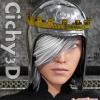rigging question
 Cichy3D
Posts: 132
Cichy3D
Posts: 132
I've had a question about rigging a figure. I finished up my model which is a dragon and I'm trying to figure out how to go about rigging it. I've began adding bones and I was wondering how do you go about mirroring certain bones. The figure is symmetrical so I'd like to have exact same aligment in lets say both legs. How would I go about doing that?


Comments
How much do you know about rigging tools in DAZ Studio? - would be my first question.
Secondly - you will have to create your bones manualy and just apply "Mirror Joints" function to them after you positioned one side correctly.
You could also use Figure Setup to place your bones - which might be the way to go on a big figure. That will require some preparation though.
By the way - judging by your nickname:
"Jeżeli by zaszła taka potrzeba, zawsze możemy porozmawiać o tym po Polsku."
I've been trying to follow some youtube guides but it seems like they are outdated. However, I think I finally figured out which menus I need to use but yeah this is my first attempt at rigging so it's all new to me.
I made this and wanted to rig it so I can see how well it will hold up.
p.s. Tak mowie po Polsku haha dobre masz oko
I wish my Guide was already out - that way I could just point you to the freshest Documentation for rigging tools I have.
Well - this might take a bit of time, hope you are not in a hurry. I'll try to guide you with the process. I'll keep this in english, in case someone was interested in the process as well.
So first things first - Open the Tool Settings Tab and dock it somewhere comfortable. In that tab, choose Geometry Editor. You will first need to create Face groups for your Dragon.
Now, think of Face groups as "places you would click on a mesh to select the body part you wish to move". Additionally, consider them "the mesh that is moved by a bone inside the figure".
If you check any of the Genesis line models, you will get a better grasp of how they are made.
So - your Dragon wil have Face groups for the Head, neck, (maybe even Upper and Lower Neck at that), Chest, Abdomen, Hip, etc. You gotta assign all the Polygons available into such Face Groups. (Note, we're not speaking Surfaces here.) Heads up - there will be a LOT of Face Groups on that Dragon. If you check Genesis figures you will see that yourself.
Once that is done, you will have two options.
1) Use the Joint Editor and manually put every single bone on the figure. (Which I would nto recommend - as that takes a lot of time for a big figure like that, even if you use the Mirror Joints option)
2) Export the Dragon as a .OBJ file and use Figure Setup to quickly create a rig for the figure. Which I would recommend.
I would suggest using Figure Setup. You can open that tab via Window -> Panes (tabs) -> Figure Setup.
Once all that is done, you will have to create General Weight maps for the Root bone (hip) and all the other bones. You can use the Node Weight Map Brush to do it. Once you have created all the General Weights on the figure, go to the Binding tab of the Node Weight Map Brush.
In the tab, as your Weight Mapping Mode choose 'general"
As General Weight Node choose "Dual Quaternion"
As Scale Weight Mode choose "Binding".
Now with the Node Weight Map brush, right click in the viewport. Go to Weight Editing -> Fill by Bone Selection Groups.
Now you can switch to the Universal Tool and check if the Dragon moves its parts. It might look glitchy - but we will fix that once you get to this point, so worry not. A lot of work ahead of us.
thanks so much!